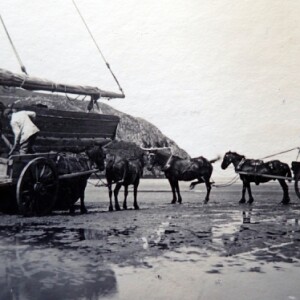A life on the ocean wave
Ein Hanes/Our History, the local 'heritage centre' I'm involved with, has been loaned an album of pictures by a local photographer who was active around the end of the 19thC. I spent my morning there perusing the images. Many are of the town itself and probably mostly of interest to folk who know it well and can compare today with yesteryear.
Here are just a few on the same theme: ships. The main picture shows the (old) harbour, essentially unchanged today except that what were working people's cottages along and above the quay are now almost all holiday lets and the boats there now are mostly pleasure craft. The luggers in the old photo were the equivalent of today's trucks; they brought in supplies of food, building materials and other necessities from near and far. There were regular trading routes between England (Bristol) and Ireland as well as between local harbours.
The first extra shows how these ships were unloaded. Once beached by the ebb tide, horses and carts were used to take off the goods. It looks as if a man is shovelling material outof the hold (coal perhaps, or limestone for the kilns close by) while a lad waits with another cart.
Some ships came from much further away. The second extra had a title: "The Lady Cairns - mail from America". This was surprising enough but a little research revealed a grim story. The Lady Cairns, an iron sailing ship, was built by Harland and Wolff in 1869 and had been based first at Dublin and then at Swansea docks - presumably where she was headed after dropping into Fishguard.
A few years later.... (quoting from the Dublin Port Archive)
"It was a cold morning in March 1904. The sun was only rising. The fog was so heavy even the light struggled to shine through. One could smell a storm brewing in the breeze. The waves punched the hull of the barque Mona with violence. She was heading southeast as the mist got hazier and hazier. The deep cries of her fog-horn reverberated around and strayed into the fest. It was almost impossible to guess the Kish Light, barely 12 miles away. Unexpectedly, the crew realized they weren’t alone. They heard the blasts of another horn coming from their starboard bow. They looked and saw nothing. Only the lookout man noticed an over-canvassed ship (with no lookout of its own) on its port bow. Only half a mile away. The pilot tried to slow the Mona by bracing her sails aback. Alas, it was too late. Both vessels collided and the mysterious ship sunk [sic] in the Irish sea in minutes. The cries of the 18 souls of the crew faded into the wind."
The stricken ship was the Lady Cairns. The failure of the Mona's captain to go to her aid or to attempt any rescue of her crew caused a scandal. There was a court case but the absence of any survivors from the Lady Cairns made it hard to reach a decisive conclusion.
"The event greatly stirred public opinion. Its importance was such that James Joyce mentions it in his masterpiece Ulysses. While Bloom is in a bookshop nearby, an elderly lady left the Four Courts, having heard the case."
You can read the full story here.
Life on the Ocean Wave
A life on the ocean wave!
A home on the rolling deep!
Where the scatter'd waters rave, and the winds their revels keep;
Like an eagle cag'd I pine,
On this dull, unchanging shore;
Oh give me the flashing brine,
The spray and the tempest's roar.



Comments
Sign in or get an account to comment.


